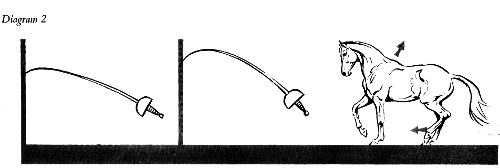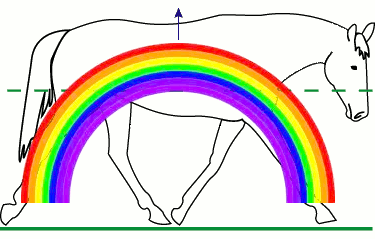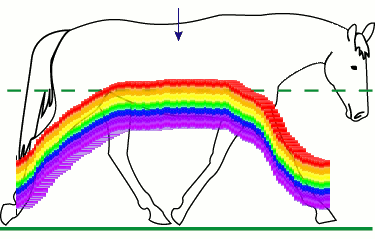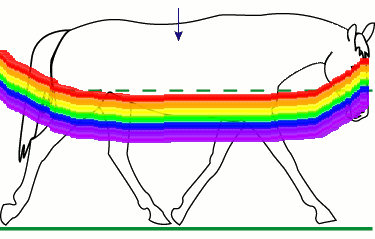|
Is your horse a little stiff on one side?
I shared an exercise from Riding Masterclass,
Lessons with 10 of Today's Top Trainers, edited by Jo Weeks, that Carl Hester advocates
in a previous post.
For consideration here is a different approach that looks at
the position of the back and how
it is used.
edited by Jo Weeks, that Carl Hester advocates
in a previous post.
For consideration here is a different approach that looks at
the position of the back and how
it is used.
This builds upon classical ideas of how a horse uses
itself. Ideally, the horse has a beautiful, upward bow
from the hind foot to the poll and is carrying itself
well. The hips and withers are 'under' the back,
as illustrated in diagrams from
Effective Horsemanship,
by Noel Jackson.  What often happens, though, is that somehow this
gets upside down and the backend is shoving the front end
forward and usually down.  Since that list of disasters
(of 'somehow') is long
and depressing, let's avoid it! and just look at a way
to get back on track. The 'problem' is that the top of
the bow is not high enough, and that's enough to start
finding a solution -- basically: get the top of the bow back
on top of what carries it! To do this, we can use a
Centered Riding approach with a visual. This is the
'ideal': 
Ideally,
the horse's bow transmits kinetic energy upward.
Ideally, every stride forward, his back is coming up -- because
he's got to put his foot under his belly. So there is
this rippling 'upward' sensation through the horse followed
by a gentle wafting downward of the forefeet.
You use this image by contrasting the ideal with the
current.
To begin, when you ride the rainbow, you want to first ask 'What
kind of rainbow am I sitting on?' If you have a stiff
horse, your rainbow might look something like:

or worse:

The rainbow on the horse's left side might look different than
the rainbow on the horse's right side. The trick is to first
get information about the rainbow you have.
To find out what your rainbow is, you ask yourself:
"What does my rainbow look like/feel like/sound
like?" And then your brain makes something up and
you pay attention to it. You say to yourself:
"Hey - thanks for that info!"
If your brain comes back with a perfect rainbow and your
horse is stiff, then you can guess something is off in your
feedback loop but all is not lost. If it comes back
with some flattened, flipped, or otherwise messed up
rainbow, you have your 'marching orders.'
Technique 1) - overall
a) say to yourself: "Hey - here's the rainbow we've
got (flash on the current rainbow) and this is the one
we want (flash on the ideal rainbow) - how do you want to
get there?" (you can either juxtapose the two
images by switching between them or superimpose them one of
top of each other.)
b) allow your body to adjust itself
c) repeat until your current rainbow and ideal rainbow
match.
Technique 2) - specific parts
a) say to yourself: "Hey - here's the rainbow we've
got (flash on the current rainbow) and it's <for
instance: going down in the middle, not up> - I want that
section to <for instance: go up.> What do you
want to do to get there?"
b) allow the body to adjust
c) repeat until it's good enough then pick a different
part to attend to. examples are:
- the ends of the rainbow are flipped up, one or both
- the ends of the rainbow aren't under the horse, one of
both
- the rainbow is too flat
- the rainbow bow is too far forward, too far backward,
off to the side, etc.
Technique 3) - my picture says it's perfect but my horse
sure feels stiff anyway
a) say to yourself: "Hey - I want a higher
rainbow!" - say this especially to the side that is
stiff.
b) allow your body to deliver on that.
- or -
a) say to yourself: "What if we flatten that just a
little bit more?" - especially on the stiff side
b) let your body experience this.
In the first instance, you're asking for more of what you
want. In the second instance, you're emphasizing what
you suspect is going on, which clarifies it and allows the
body to correct it.
WELL - who knew that would take so long to type!
When you get good at this you can do it within each stride -
you watch the rainbow the entire time the foot is on the
ground and then in flight.
There are other considerations as well - like what you're
doing with your hands and legs. You want them moving
in harmony with your horse, not against it. More on
that next time!
ps - are you thinking, wait, why didn't we 'fix the
horse?!' by changing yourself, specifically what
you're aware of and thinking, you're providing your horse an
example through leadership. It is, in the long run,
more effective and long lasting than physical manipulations.
|




![Centered Riding Today: An Informal Talk by Sally Swift [VHS]](http://ecx.images-amazon.com/images/I/41Vn6PfhzML._SL125_.jpg)
![Centered Riding with Sally Swift [VHS]](http://ecx.images-amazon.com/images/I/51OSh9kd9iL._SL125_.jpg)






